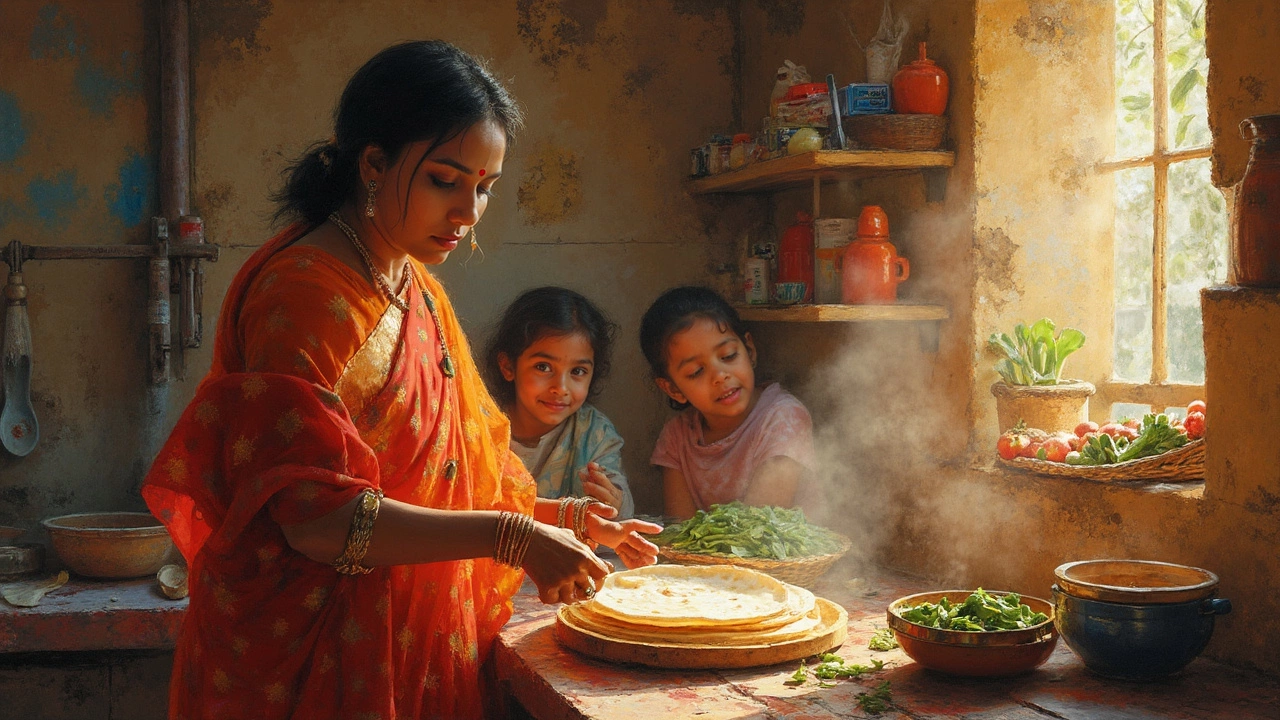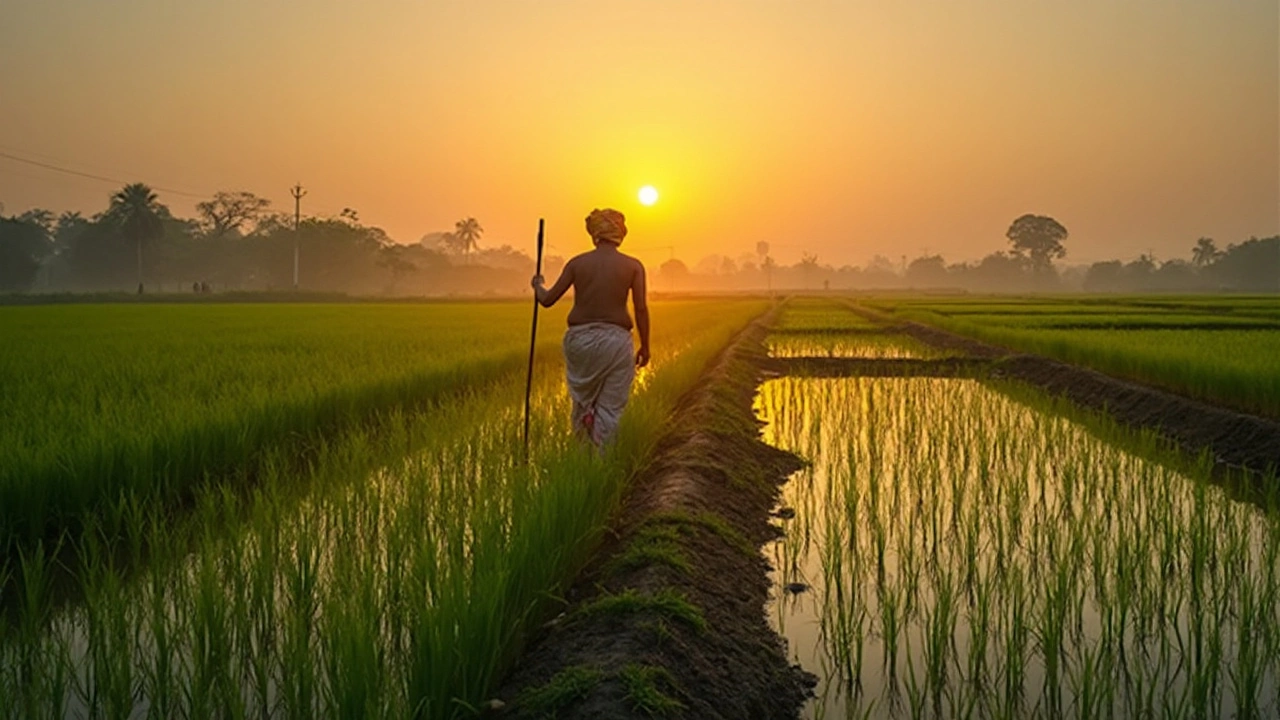Roti vs. Rice Calories: What's on Your Plate?
 Feb, 25 2025
Feb, 25 2025
Here's the deal: if you’re watching calories, choosing between roti and rice can be a bit puzzling. Let’s break it down simply. A single plain roti, roughly 6 inches in diameter, packs about 70 to 80 calories. Pretty neat, right? But hold on! When you start slathering ghee over it, prepare for a jump. One roti with ghee can take your tally to around 150 calories.
Rice, on the other hand, sings a different tune. One cup of cooked white rice comes with nearly 200 calories, but that’s just the plain version. The minute you add flavors or oils, the calorie count climbs up. So, what's the takeaway? It's all about balancing flavors and numbers.
- The Caloric Breakdown
- Interesting Facts About Roti and Rice
- Tips for Healthier Meals
- Balancing Your Diet
The Caloric Breakdown
Choosing between roti and rice can feel like a culinary conundrum, but it's easier when you know what's on your plate. First, let’s chat about calories in 1 roti. As mentioned earlier, a plain roti roughly carries 70 to 80 calories. This makes it a light yet satisfying option for those managing their calorie intake.
But what if you enjoy your roti with some delicious extras? Adding ghee elevates the flavor but also the calorie count to around 150 per piece. That’s almost double the calories, so moderation is key here!
Comparing with Rice
Now onto rice. One cup of cooked white rice has about 200 calories. It's a significant number if you're pairing it with other calorie-dense foods. If you reach for brown rice instead, expect a slight increase in calories and fiber—great for keeping you full longer.
| Food Item | Calories |
|---|---|
| Plain Roti | 70-80 |
| Roti with Ghee | 150 |
| Cooked White Rice (1 cup) | 200 |
So, how do you decide which is better for you? Here's a suggestion! If you're going carb-heavy with rice, balance it out with veggies and lean protein. For roti, if ghee is a must, consider limiting yourself to one piece or pairing it with low-calorie sabzi to keep your meals nutritious.
Ultimately, it’s your preference and health goals that should guide your choice. Keep these numbers in your back pocket when planning meals, and remember, it's all about balance.
Interesting Facts About Roti and Rice
Roti and rice—two staples in many homes, but each with its own charm. Let’s unravel some fun facts about these two ingredients.
Roti: The Versatile Flatbread
Did you know that the humble roti is a powerhouse of health benefits? Made from whole wheat flour, it’s rich in fiber which aids digestion and keeps you full longer. Caloric content in roti is relatively low compared to its size, making it a favorite for calorie-conscious eaters.
Here's a cool tidbit: Rotis made with millet or barley flour can dial up nutritional value even more. So, if you're looking to mix up your grain game, experimenting with different flours can be a great idea.
Rice: More Than Just White Rice
Though commonly associated with white rice, this grain universe is vast. Brown rice, for instance, is nutrient-packed, offering more fiber and minerals. It's higher in calories than a plain roti because of the carbohydrates, but it’s also more filling.
Surprising fact: Did you know that parboiled rice retains more nutrients than regular white rice? It's like getting the best of both worlds—a softer texture with extra nutrition.
The Age-Old Dilemma: Roti or Rice?
Choosing between roti and rice often depends on your dietary goals. If you’re counting calories, sticking with calories in roti and pairing it with sabzi might often be lighter. But if you want energy for a long day ahead, a bowl of rice might just do the trick.
Final tip: Incorporating both into your diet ensures variety. After all, balance is key!

Tips for Healthier Meals
So, you're trying to make smarter choices with your meals. Great! Here are some easy and practical tips to keep your calorie count in check without skimping on taste.
1. Portion Control
Start by managing your portions. It’s easy to overindulge in rice or rotis. Aim for about one medium-sized roti or half a cup of rice per meal as your base. This keeps calories in check and leaves room for more colorful veggies.
2. Load Up on Vegetables
Pair your 1 roti with a variety of vegetables. Not only does this add flavor and nutrients, but it also helps you feel fuller longer. Aim for a rainbow on your plate—carrots, spinach, bell peppers—to get a range of nutrients.
3. Choose Whole Grains
Whole wheat rotis and brown rice are your friends. They not only enhance the taste but boost your fiber intake, which can keep you satisfied and support your digestion.
4. Easy on the Add-Ons
Enjoy your 1 roti with ghee if you must, but keep it moderate. A teaspoon of ghee is all you need for flavor without overdoing the calories. It's about savoring, not saturating.
5. Balanced Meals
Balance your meals with protein. Lentils, beans, or a lean source of meat can round out your meal, providing essential nutrients without the caloric overload.
- Swap white rice for quinoa to add more protein.
- Use a smaller plate to trick your mind into feeling full with less.
- Cook with spices rather than calorie-rich sauces.
Remember, a healthier meal is about balance and satisfaction. By keeping these tips in mind, you can enjoy the benefits of both roti and rice without compromising your health goals. Happy dining!
Balancing Your Diet
Finding the right balance between roti and rice isn’t rocket science, but it does take a little know-how and attention to your personal needs. Are you ready to dive in?
Know Your Portions
Portion control is crucial. If you're opting for calories in roti, remember that adding ghee increases those numbers. Stick with plain roti when you're looking to cut down. As for rice, try substituting white with brown rice. It’s got the same calories but packs in more fiber, helping keep you full for longer.
Mix and Match
Here’s a trick: mixing smaller portions of both gives variety and balanced nutrition. Aim for half a cup of rice and one roti in a meal. Pairing them with veggies and lean proteins is key. These add nutrients and keep the calorie count in check, not to mention that they taste great!
Watch the Add-ons
We love our sides—sabzi, curries, you name it! But how do they impact calories? Generally, calories in 1 roti and sabzi might be lighter depending on how you prepare your vegetables. Opt for steaming or grilling instead of frying. Also, go easy on the heavy curries or gravies. They can rack up those numbers really fast.
Plan Your Meals
Planning means success. Here’s a simple way:
- Decide your carbs—plain or with ghee?
- Add a good serving of vegetables. Steamed or raw is best.
- Pick a lean protein source like legumes or chicken.
Stick to this template, and you're all set for balanced meals without the calorie shock!
Remember, the goal isn't just counting calories—it’s about making meals that nourish and satisfy. That’s how you win at diet balance!